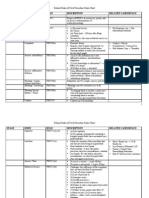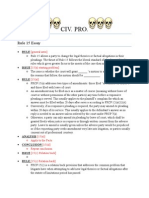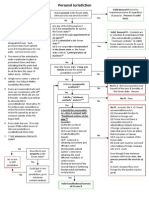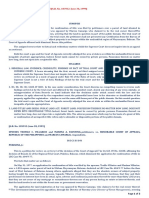Pleadings Step by Step
Pleadings Step by Step
Uploaded by
LazinessPerSeCopyright:
Available Formats
Pleadings Step by Step
Pleadings Step by Step
Uploaded by
LazinessPerSeOriginal Description:
Copyright
Available Formats
Share this document
Did you find this document useful?
Is this content inappropriate?
Copyright:
Available Formats
Pleadings Step by Step
Pleadings Step by Step
Uploaded by
LazinessPerSeCopyright:
Available Formats
PLEADINGS STEP BY STEP
1) R.7 Pleadings Allowed; Form of Motions
a) R.7(a) List: Lists out what pleadings are allowed (complaint, answer to complaint, etc) b) R.7(b) Test: Request for court order must be made by motion. Motion must: (1) Be in writing unless made heard during trial; (2) State with particularity the grounds for seeking the order; and (3) State relief sought.
2) R.8 Claim for Relief
a) R.8(a): Pleading that states a claim for relief must contain: (1) Short and plain statement of grounds for courts jurisdiction, (2) Short and plain statement showing pleader is entitled to relief; and (3) Demand for relief sought, which may include relief in the alternative/different types. i) Iqbal 2-Step: [1] Strike conclusory statements. [2] Figure out whether pleading is plausible. ii) Iqbal Notes: Iqbal used to show P entitled to relief. Conclusory statements merely allege D caused Ps injury, but not how. Plausibility means complaint is sufficient enough to convince a judge that the P actually stands a reasonable chance of proving the claims asserted. b) Alternative/Inconsistent: Alternative/inconsistent claims or defenses are allowed.
3) R.8 Defenses and Denials
a) R.8(b)(1) Rule: D must: (1) State in short and plain terms its defenses to each claim asserted against it; and (2) admit or deny the allegations asserted. i) Denial: Denial must fairly respond to substance of allegation. A) Types: General denial = all allegations denied in good faith. Specific denial = self-explan. B) Partial: Party that intends to deny only part in good faith must admit the part that is true. ii) I Dunno: Party that lacks knowledge/info to form a belief can claim, and it = denial. If incomplete research shows claim to be true, can still I dunno full research isnt complete. iii) Admission: If not denied/I dunno, assertion is admitted. Plus D can just admit it. b) R.8(c) Defenses: Responding party must affirmatively state any aff-D following list (AoR, Contrib, etc).
4) R.11 Ethical Pleading
a) R.11(b) Step 1: Party certifies they have made an inquiry, reasonable under the circumstances, before taking the position asserted in the pleading. b) R.11(b) Step 2: Party also certifies: i) Impropriety: Pleading is not presented for an improper purpose/frivolous. ii) Plausible Argument: Party has a rational argument for the position, which hasnt been rejected so recently by courts of the jurisdiction that the argument is just obstinate. iii) Evidentiary Support: [1] Factual allegations/denials have evidentiary support; or [2] Allegations/denials will likely have evidentiary support after a reasonable opportunity for discovery. (Party doesnt have much at the moment, but certifies that they expect to find more).
5) R.15 Amendment Timing
a) Before Trial: Party may amend its pleading once freely within: i) No Response-Required Pleading: 21 days after serving it, or ii) Response-Required Pleading: If the pleading is one to which a responsive pleading is required, 21 days after service of a responsive pleading OR 21 days after service of a motion under R.12(b)/(e)/(f), whichever is earlier. Time is not cumulative for RP/Motion. iii) All Other Cases: Party may amend only with opposing partys written consent or courts leave. Court should give leave freely when justice so requires. b) After/During Trial Objection: Court should allow amendment when justice requires if objection is raised that evidence presented is not within the issues raised in pleadings. c) After/During Trial Consent: When an issue not raised by the pleadings is tried by the parties express or consent, it must be treated in all respects as if raised in the pleadings.
6) R.15 Amendment Relates Back to Date of Original Pleading When. . .
a) When Needed: P seeks to amend to add/change nature of claims after the S/L has expired. b) Statutory: Law that provides the S/L allows relation back; c) Similar Transaction: Amendment asserts a claim/defense that arose out of the conduct, transaction, or occurrence set out or attempted to be set out in the original pleading; or d) Adding Person: Amendment changes party/name of party against who claim is asserted relates back if i) Adding Requirement 1: Similar Transaction satisfied (R.15(c)(1)(B) above);
i) Adding Requirement 2: Defending party received such notice of the action that it will not be prejudiced in defending on the merits; and ii) Adding Requirement 3: Defending party knew or should have known that the action would have been brought against it, but for a mistake concerning the proper partys identity.
7) R.12 Defensive Motions
a) R.12(b) Notes: Any R.12(b) motion may be filed before the Ds responsive pleading. D does not have to make a pre-trial motion can raise any one of them in her answer instead. b) List of Motions: Contained in R.12(b), along with one in 12(e) which says the Ps complaint is too vague. c) R.12(g) Notes: Can only file available pre-answer motions at one time. i.e. Cant just continue asserting one-by-one motions to delay trial. However, only applies to available motions. i.e. If the first motion is a 12(e) failure to understand complaint, then a 12(b)(6) was not available, but a 12(b)(2) was. d) Disfavored Defense Waiver: [1] Is the defense listed in R.12(h)(1)? [2a] Was the disfavored defense omitted a la R.12(g)(2)? OR [2b] Did the party fail to raise the disfavored defense in a motion / include it in a responsive pleading or in an amendment allowed by R.15(a)(1) as a matter of course? IF YES -> DEFENSE WAIVED. e) Other Defenses Waiver: [1] Is the defense listed in R.12(h)(2)? IF YES -> Defense may be raised in [A] any pleading allowed or ordered under R.7(a), [B] by a motion under R.12(c), or [C] at trial. f) Lack of SMJ: Can be raised at ANY time.
You might also like
- FRCP ChartDocument11 pagesFRCP Chartjcabral12100% (40)
- Teacher Employment ContractDocument2 pagesTeacher Employment ContractDuke Sucgang94% (17)
- Civ Pro ChartsDocument11 pagesCiv Pro Chartsjhriter100% (16)
- Joinder ChartDocument3 pagesJoinder ChartDavid Patton100% (3)
- Civ Pro Freer OutlineDocument12 pagesCiv Pro Freer OutlineDanielle D'Ambrosio100% (7)
- Battery: Intentional Infliction of Emotional DistressDocument9 pagesBattery: Intentional Infliction of Emotional Distresslearninghand96% (24)
- Removal FlowchartDocument1 pageRemoval FlowchartzdayarNo ratings yet
- Civ Pro Skeleton AnswersDocument5 pagesCiv Pro Skeleton AnswersWyattjames4100% (14)
- Issue Preclusion: (No Fraud, Lack of SMJ, Venue, Joinder, Oppty To Be Heard Issues) No IpDocument8 pagesIssue Preclusion: (No Fraud, Lack of SMJ, Venue, Joinder, Oppty To Be Heard Issues) No Ipsgussack100% (4)
- Civ Pro Attack SheetDocument1 pageCiv Pro Attack Sheetsumsanslimites82% (11)
- FRCP 26 ChartDocument1 pageFRCP 26 ChartRonnie Barcena Jr.50% (6)
- Attack Outline For Civil ProcedureDocument6 pagesAttack Outline For Civil Procedure1Life167% (3)
- Civil Procedure - Erie EssayDocument2 pagesCivil Procedure - Erie Essayjustgottabezen100% (1)
- Civil Procedure FRCP TableDocument20 pagesCivil Procedure FRCP TableIsaiah Paramore100% (2)
- Joinder of Claims ChartDocument1 pageJoinder of Claims ChartRonnie Barcena Jr.No ratings yet
- CIV Pro Plan of AttackDocument3 pagesCIV Pro Plan of Attackrmthom100% (18)
- Civ Pro Flow ChartDocument8 pagesCiv Pro Flow Chartnhjefferson100% (2)
- Civpro FlowchartDocument4 pagesCivpro FlowchartDawn J. Owens100% (7)
- Personal Jurisdiction FlowchartsDocument2 pagesPersonal Jurisdiction FlowchartsAlodieEfamba100% (5)
- Civ Pro Outline 2021Document71 pagesCiv Pro Outline 2021AmandaNo ratings yet
- Erie Doctrine Flow ChartDocument1 pageErie Doctrine Flow Chartdmt320100% (2)
- Civil Procedure Outline Keyed To Yeazell (7th Edition)Document42 pagesCivil Procedure Outline Keyed To Yeazell (7th Edition)elyza987100% (12)
- Rules Flow ChartDocument6 pagesRules Flow Chartmrgoldsmith23100% (7)
- Erie Doctrine FlowchartDocument1 pageErie Doctrine FlowchartElizabeth Andonova100% (2)
- FRCP 56 Summary Judgment ChartDocument2 pagesFRCP 56 Summary Judgment ChartRonnie Barcena Jr.100% (5)
- Exam Answer Outline-TortsDocument3 pagesExam Answer Outline-TortsAhmad A. Hussein100% (1)
- Evolution of The Erie DoctrineDocument2 pagesEvolution of The Erie Doctrineebpgilbert100% (1)
- Civpro Flow ChartsDocument3 pagesCivpro Flow ChartsLauren Walker100% (2)
- 1S CivPDocument1 page1S CivPac70119No ratings yet
- Tort Cheat SheetDocument2 pagesTort Cheat Sheetjorgenslots100% (5)
- Torts OutlineDocument23 pagesTorts OutlineJ3NLYN100% (2)
- Joinder of Parties StepbyStepDocument3 pagesJoinder of Parties StepbyStepLazinessPerSe100% (5)
- Preclusion Step by StepDocument2 pagesPreclusion Step by StepLazinessPerSe100% (2)
- 1L Personal Jurisdiction Final OutlineDocument2 pages1L Personal Jurisdiction Final OutlineMichelle ChuNo ratings yet
- Preclusion Step by StepDocument2 pagesPreclusion Step by StepLazinessPerSe100% (2)
- Joinder of Parties StepbyStepDocument3 pagesJoinder of Parties StepbyStepLazinessPerSe100% (5)
- CrimLaw AttackDocument31 pagesCrimLaw AttackLazinessPerSe100% (10)
- Ucp 600Document4 pagesUcp 600Gaytri KochharNo ratings yet
- Beat Exclusive License-EnglishDocument3 pagesBeat Exclusive License-Englishsoundstarz musicNo ratings yet
- Erie Flow ChartDocument1 pageErie Flow ChartMichael WeilNo ratings yet
- Joinder of Claims StepbyStepDocument1 pageJoinder of Claims StepbyStepLazinessPerSe100% (2)
- Joinder-Big Picture: R J I R Diver TyDocument1 pageJoinder-Big Picture: R J I R Diver Tysafkdjafgh leeeNo ratings yet
- Civil Procedure OutlineDocument34 pagesCivil Procedure OutlineMason David100% (8)
- Erie Doctrine OutlineDocument4 pagesErie Doctrine OutlineDavid Jules Bakal100% (1)
- Personal Jurisdiction Attack OutlineDocument1 pagePersonal Jurisdiction Attack OutlineHaley Walker100% (1)
- Claim Preclusion Attack OutlineDocument2 pagesClaim Preclusion Attack OutlineRonnie Barcena Jr.100% (3)
- CivPro - InterpleadersDocument2 pagesCivPro - InterpleadersLaura CNo ratings yet
- Supplemental Jurisdiction FlowchartDocument1 pageSupplemental Jurisdiction FlowchartYenisNo ratings yet
- The Erie Doctrine: Erie Railroad Co V Tompkins, 1938Document5 pagesThe Erie Doctrine: Erie Railroad Co V Tompkins, 1938Onyi IbeNo ratings yet
- Civ Pro Case ChartDocument14 pagesCiv Pro Case ChartMadeline Taylor DiazNo ratings yet
- Civil Procedure Outline 2019Document16 pagesCivil Procedure Outline 2019Jennifer Lyons100% (1)
- Civ Pro Rules OutlineDocument12 pagesCiv Pro Rules OutlineShelby BullittNo ratings yet
- Civil Procedure - Freer Fall 00 01Document27 pagesCivil Procedure - Freer Fall 00 01lssucks1234No ratings yet
- Erie Flow ChartDocument1 pageErie Flow ChartDhvanil Zaveri100% (2)
- Torts Final OutlineDocument37 pagesTorts Final OutlineMichael Seveska100% (1)
- Civ Pro Flow ChecklistDocument8 pagesCiv Pro Flow ChecklistSarah BrathwaiteNo ratings yet
- Claim & Issue PreclusionDocument1 pageClaim & Issue Preclusionkevand123No ratings yet
- Civil Procedure RoadmapsDocument15 pagesCivil Procedure RoadmapsCarolina JordanNo ratings yet
- Exam Outline Civ ProDocument24 pagesExam Outline Civ ProPuruda Amit100% (1)
- Torts I Outline ElementsDocument14 pagesTorts I Outline Elements77bribri77No ratings yet
- Torts ChecklistDocument6 pagesTorts ChecklistRui BuNo ratings yet
- Business Organizations: Outlines and Case Summaries: Law School Survival Guides, #10From EverandBusiness Organizations: Outlines and Case Summaries: Law School Survival Guides, #10No ratings yet
- KP FRCP Fall Civ ProDocument14 pagesKP FRCP Fall Civ ProadamNo ratings yet
- Civil Procedure OutlineDocument24 pagesCivil Procedure OutlineBrittany Thompson100% (1)
- Support After Opportunity For DiscoveryDocument7 pagesSupport After Opportunity For DiscoveryTyler ChurchNo ratings yet
- Property OutlineDocument14 pagesProperty OutlineLazinessPerSe100% (2)
- Habeas Corpus AnalysisDocument6 pagesHabeas Corpus AnalysisLazinessPerSeNo ratings yet
- Property Review OutlineDocument22 pagesProperty Review OutlineLazinessPerSe100% (1)
- Parol Evidence Rule Step by StepDocument2 pagesParol Evidence Rule Step by StepLazinessPerSe100% (4)
- UE - MO Step by StepDocument2 pagesUE - MO Step by StepLazinessPerSeNo ratings yet
- Supervening Issues Step by StepDocument2 pagesSupervening Issues Step by StepLazinessPerSeNo ratings yet
- Interpretation - Construction Step by StepDocument2 pagesInterpretation - Construction Step by StepLazinessPerSe100% (1)
- Conditions Step by StepDocument1 pageConditions Step by StepLazinessPerSe100% (1)
- Improper Bargaining Step by StepDocument3 pagesImproper Bargaining Step by StepLazinessPerSe100% (1)
- Joinder of Claims StepbyStepDocument1 pageJoinder of Claims StepbyStepLazinessPerSe100% (2)
- 12 (B) (6) Vs Summary Judgment StepbyStepDocument1 page12 (B) (6) Vs Summary Judgment StepbyStepLazinessPerSe50% (2)
- 1 - Instructions - Enforcement ProcessDocument5 pages1 - Instructions - Enforcement Processrhouse_1100% (5)
- Declaration of Original Depository and DepositDocument2 pagesDeclaration of Original Depository and DepositIAM-cs-02271971No ratings yet
- Request For Authority To PracticeDocument2 pagesRequest For Authority To PracticeAura Garcia-Gabriel100% (2)
- Villivakkam Panchayat UnionDocument3 pagesVillivakkam Panchayat Unionபூவை ஜெ ரூபன்சார்லஸ்No ratings yet
- Declaration of Douglas Schmitz 02-04-15 (m130391)Document2 pagesDeclaration of Douglas Schmitz 02-04-15 (m130391)L. A. PatersonNo ratings yet
- Young Vs SyDocument21 pagesYoung Vs SyHariette Kim TiongsonNo ratings yet
- Notes On TrademarkDocument2 pagesNotes On TrademarkmilleranNo ratings yet
- Ablaza vs. RepublicDocument17 pagesAblaza vs. RepublicDexter CircaNo ratings yet
- Lagunzad Vs Soto Vda. de GonzalesDocument2 pagesLagunzad Vs Soto Vda. de GonzalesGladys Bantilan100% (1)
- PSBANK Premium CheckingDocument2 pagesPSBANK Premium CheckingMacris MallariNo ratings yet
- D2b - 7 Delos Santos v. CoADocument3 pagesD2b - 7 Delos Santos v. CoAAaron AristonNo ratings yet
- Laguna V Manabat, 58 Scra 650Document5 pagesLaguna V Manabat, 58 Scra 650Kim Laurente-AlibNo ratings yet
- Romualdez-Marcos v. ComelecDocument2 pagesRomualdez-Marcos v. ComelecSecret Student100% (1)
- Aboitiz Equity Ventures, Inc. V ChiongbianDocument36 pagesAboitiz Equity Ventures, Inc. V ChiongbianCarlo Mercado100% (1)
- Saket Damanreet Kaur Vs Indermeet Singh JunejaDocument3 pagesSaket Damanreet Kaur Vs Indermeet Singh JunejadaljitsodhiNo ratings yet
- Discharge of Contract: Presented By: Nimesh PrajapatiDocument17 pagesDischarge of Contract: Presented By: Nimesh PrajapatiNimesh PrajapatiNo ratings yet
- APHB Application FormDocument4 pagesAPHB Application FormtomsraoNo ratings yet
- Public Arrest Report For 9232013Document5 pagesPublic Arrest Report For 9232013api-214091549No ratings yet
- Villarico vs. CA, 309 SCRA 193Document3 pagesVillarico vs. CA, 309 SCRA 193FranzMordenoNo ratings yet
- DS TexMACS Medium RGDocument1 pageDS TexMACS Medium RGMáximo DíazNo ratings yet
- Indice Notarial 2016-2017Document17 pagesIndice Notarial 2016-2017Yeizon CanoNo ratings yet
- Herman D. Coloma For Petitioners. Jorge S. Castillo For Private RespondentDocument5 pagesHerman D. Coloma For Petitioners. Jorge S. Castillo For Private RespondentRose De JesusNo ratings yet
- SPA - TemplateDocument2 pagesSPA - TemplateCandice Tongco-CruzNo ratings yet
- School Accreditation - Bureau of ImmigrationDocument1 pageSchool Accreditation - Bureau of ImmigrationClint Richard ChuaNo ratings yet
- The Right To Fair Compensation and Transparency in Land Acquisition Rehabilitation PrintedDocument3 pagesThe Right To Fair Compensation and Transparency in Land Acquisition Rehabilitation PrintedPragnyaraj BisoyiNo ratings yet
- European Resources and Technologies, Inc. V WenceslaoDocument5 pagesEuropean Resources and Technologies, Inc. V WenceslaoJohn YeungNo ratings yet
- Entry Form Fun Run 2016Document4 pagesEntry Form Fun Run 2016Tulaynalupa NationalhighschoolNo ratings yet




































































































